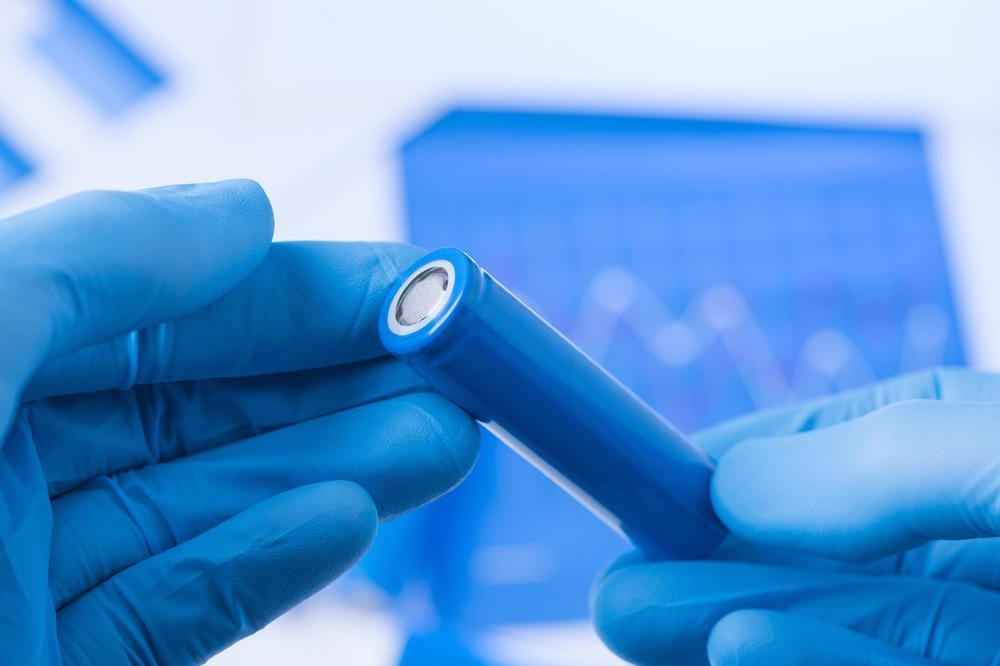As fossil fuel supplies dwindle and the climate emergency worsens, both the grid energy storage sector and the automotive industry are increasing their efforts to develop robust and efficient energy storage technologies. New research in the Journal of Power Sources considers ways to optimize the operating capacity of LiVO3 Cathodes in Li-Ion Batteries.

Study: Boosting capacity and operating voltage of LiVO3 as cathode for lithium-ion batteries by activating oxygen reaction in the lattice. Image Credit: nevodka/Shutterstock.com
Electric vehicles (EVs) remain at the forefront of these developments, with advanced rechargeable lithium-ion batteries (LIBs) offering consumers an appealing and more environmentally friendly alternative to conventional combustion engines.
Work is ongoing to develop LIBs with higher energy density—a key factor in increasing the maximum driving distance and competitive advantage of EVs.
One of the most promising means of improving this energy density lies in broadening LIBs’ charge cut-off voltage, allowing manufacturers to extract more lithium from the material and therefore improve the capacity of the LIB.
The most notable barrier to this process stems from the fact that removal of a larger portion of lithium from the layered structure leads to lattice instability, in turn leading to rapid capacity fading as the battery cycles.
One potential means of overcoming this barrier lies in the use of lithium-rich transition metal oxides. These materials offer excellent specific capacity when charged to higher voltages, reported being more than 250 mAh g−1 or higher when charged to 4.8 V.
The benefits of these lithium-rich materials are largely due to their charging leading to the activation of anionic redox reactions (ARRs) involving oxygen anions. These oxygen anions are able to transfer electrons as transition metals (TMs) and are replaced by lithium.
Forthcoming research in the Journal of Power Sources has suggested a means of optimizing this process and helping to mitigate some of the capacity fading and voltage decay issues by better stabilizing the crystal structure of the oxygen atoms and transition metals employed in LIBs’ cathode configurations.
It is important to note that their structural arrangements within the lattice have a significant impact on the stability of atoms. Bonds between transition metal oxide materials are shorter – prompting stronger bond energy – when these transitions metals are coordinated tetrahedrally than those coordinated octahedrally.
Alternative Ion Separation Technique for Refining Brine Used in Li-Ion Batteries
This is a key consideration for the optimization of cathode materials, but there has thus far been little investigation into their use in battery materials despite these being potentially more stable when experiencing anionic redox reactions.
Vanadium-based materials are a popular choice for battery applications due to their capacity to undergo charge transfer.
Taking these factors into account, the researchers explored the capacity of monoclinic LiVO3 comprised of VO4 tetrahedron structures to accommodate a high cut-off voltage.
These were initially charged to 4.8 V, and it was determined that during charging, a total of 0.56 mol of lithium could be removed from the material. This, therefore, provided a reversible capacity of 136 mAh g−1, with an average potential of 3.03 V between a minimum of 2.4 V and a maximum of 4.8 V.
The researchers made use of advanced ex situ X-ray absorption spectroscopy (XAS) and X-ray photoelectron spectroscopy (XPS) techniques to measure and observe this process, discovering that the anionic redox reaction process is likely activated during the initial charge to 4.8 V, supporting a promising charge capacity.
During this study, the material was found to maintain 93% of its capacity even after 100 charge cycles, and excellent stability, even given the anionic redox reactions’ tendency to destabilize these materials.
The material’s tetrahedral coordination was a major factor in its stability, and by using ex situ synchrotron X-ray diffraction (XRD) the researchers were able to observe a negligible volume change of 0.21% as lithium is transferred out.
Improving the Rate Performance of Hard Carbon for Use in Batteries
Experiments with varying voltage ranges had minimal impact on capacity retention, though it was determined that testing LiVO3 between 1.5 V and 4.8 V enabled available capacity to be expanded to 358 mAh g−1 with an average potential of 2.55 V. These findings resulted in an incredible energy density of 912.9 Wh kg−1.
The most notable finding of this study was that by leveraging the benefits of anionic redox reactions and advanced tetrahedron coordination, it is possible to enhance materials’ capacity and operating voltage.
Future breakthroughs in battery technology—and improvements in their capacity—are a cornerstone of the mainstreaming of electric vehicles and more sustainable transport.
This research could offer a robust foundation for future studies into the use of further other novel cathode materials for battery applications. There is also excellent potential for ongoing research to optimize electrodes and electrolytes to better minimize capacity loss due to repeating charging cycles.
Disclaimer: The views expressed here are those of the author expressed in their private capacity and do not necessarily represent the views of AZoM.com Limited T/A AZoNetwork the owner and operator of this website. This disclaimer forms part of the Terms and conditions of use of this website.
Source:
Bizhe Su, Shuilin Wu, Hanqin Liang, Qinfen Gu, Huimin Wang, Wenchong Zhou, Xiaohui Zhao, Tao Zhang, Patrick H.-L. Sit, Wenjun Zhang, Denis Y.W. Yu, Boosting capacity and operating voltage of LiVO3 as cathode for lithium-ion batteries by activating oxygen reaction in the lattice, Journal of Power Sources, Volume 517, 2022, 230728, ISSN 0378-7753, https://www.sciencedirect.com/science/article/pii/S0378775321012222?via%3Dihub